YAMAHA ELS-01, ELS-01C User Manual
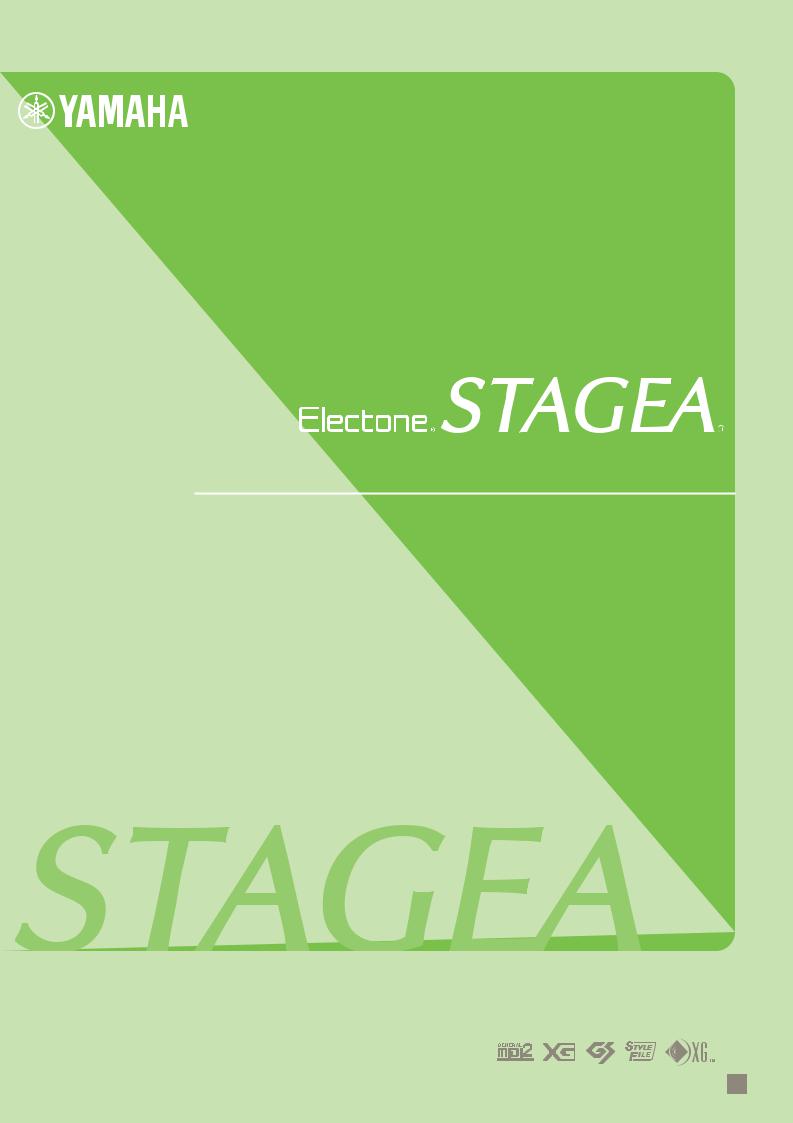
ELS-01/01C typeU
Playing the ELS-01/01C
Tutorial
EN
2 |
Playing the ELS-01/01C — Tutorial |
|
|
About This Manual
(Read this first!)
This manual is made up of four chapters, each focusing on a single song for you to practice. By playing and working on each song, you’ll build up your knowledge and experience of using the ELS-01/01C, and increase your familiarity with the functions of the instrument naturally. If you’re already familiar with the Electone or have experience playing one, feel free to start somewhere in the middle of the book, rather than the beginning. The point is to learn things about the Electone that you may not have known before, and to use them effectively in your performance.
When you need more specific instructions or want to explore a feature or function in greater detail, refer to the separate Owner’s Manual.
In addition, the Owner’s Manual contains basic information about the ELS-01/01C, such as the Panel Layout and Basic Operations (pages 8 – 21), helpful sections you should read before working through this booklet.
Now, go to the next page and take a look at the brief overviews of each chapter.
Playing the ELS-01/01C — Tutorial |
3 |
|
|

ACT 1 |
Page 6 |
Playing with the Registration Menus
Song: “Grandfather’s Clock”
Simply select the Registration from the Registration Menu and play the song. It’s not a difficult piece to play, but if you’re unfamiliar with the score, try slowing down the rhythm and playing it at a more relaxed pace. Enjoy performing with the clear oboe melody and the beautiful strings harmony.
ACT 2 |
Page 12 |
Editing a Registration and Storing it to Registration Memory
Song: “Dancing Queen”
Here, you’ll select a Registration from the Registration Menu, then slightly edit it and save to Registration Memory. Three Registration Memories (M1, M2, and M3) are used in this song. You’ll also save these Registrations to a USB flash memory. Finally, play the song and use the right footswitch to change the Registration Memory. The Lower keyboard and Pedalboard parts are very simple, letting you master this piece quickly.
M |
1 |
Creating a Simple Intro Sound based on the Registration Menu |
M |
2 |
Slightly Editing the Intro Sound |
M |
3 |
Enjoying the Original Sound of the Registration Menu |
|
|
|
4 |
Playing the ELS-01/01C — Tutorial |
|
|

ACT 3
Page 24
Selecting and Editing Voices
Working with Rhythm Sequence and Registration Sequence
Song: “Change the World”
ACT 4
In this chapter, we’ll work on creating each Registration from scratch, instead of using the Registration Menu. First, select the Voices for each Voice section and apply some controls and effects. Then, program a Rhythm Sequence and Registration Sequence.
These allow you to play the song with all the necessary changes made automatically — without your having to use the footswitch, switch Registrations or select different rhythms. Finally, record the settings and your performance to a USB flash memory.
M |
1 |
Intro with Acoustic Guitar and Electric Piano |
M |
2 |
Classic Rock Organ |
M |
3 |
Sweet Harmonica Melody |
M |
4 |
Soft Harmony with Pad Sound on the Lower Keyboard |
M |
5 |
Mysterious Arpeggio with Delay |
M |
6 |
Electric Guitar Solo |
M |
7 |
Ending with Acoustic Guitar and Electric Piano |
|
|
|
Page 60
Creating Various Organ Sounds (ELS-01C)
Song: “Moldau”
The Organ Flutes function (not available on the ELS-01) lets you create various organ sounds — such as those of a traditional pipe organ, gorgeous jazz organ, and more. “Moldau” is a short song, yet it includes a very colorful organ sound. Enjoy all of the sounds from your head down to your feet.
M |
1 |
Classical Sound |
M |
2 |
Soft Jazz Sound |
M |
3 |
Tasty Jazz Sound |
M |
4 |
Colorful Jazz Sound |
M |
5 |
Percussive Rock Sound |
M |
6 |
Classical Sound (same as M1) |
|
|
|
Playing the ELS-01/01C — Tutorial |
5 |
|
|

ACT 1
Playing with
the Registration Menus
Song:
“Grandfather’s Clock”
6 |
Playing the ELS-01/01C — Tutorial |
|
|

One of the most exciting aspects of the Electone is its abundance of realistic Voices and dynamic rhythms. For details on exactly what Voices and rhythms are available, check the Voice List and Rhythm List in the Owner’s Manual (pages 30 and 59). With all the hundreds of choices available, you may have a difficult time finding which is best for a particular song. That’s where the Registration Menu comes in handy.
Registration Menu contains 48 Registrations (60 on the ELS-01C) in five main categories: (1) Kids, (2) Pops & Rock, (3) Dance & Ballad, (4) Jazz & Latin, and (5) Symphony & World. Registration settings in the Registration Menu include not only the Voices for each keyboard — Upper, Lower and Pedal — but also the rhythm and Auto Bass Chord settings. This means you can enjoy playing the Electone with appropriate settings for any style of music or song simply by selecting the desired Registration from the Registration Menu.
About “Grandfather’s Clock”
This plaintive and poignant folk song was written by Henry Clay Work back in 1876, and was one of the two most popular songs that year in the United States — the other being “I’ll Take You Home, Kathleen.” Standing clocks like the one mentioned in the lyrics were a common fixture in homes across the country, and the image of the clock, as well as the parallel lives of the clock and the old man, captured the hearts of listeners as much as did the beautiful melody. The song has endured, renewing its popularity every generation, and has even left us with the word “grandfather clock” — meaning a standing, tallcase clock.
ACT 1
ACT 2
ACT 3
ACT 4
Playing the ELS-01/01C — Tutorial |
7 |
|
|
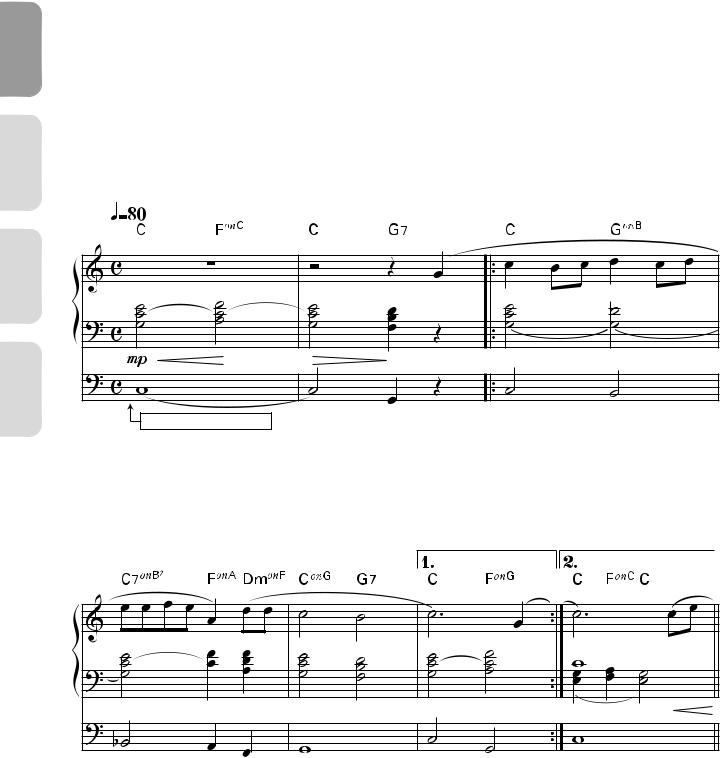
Grandfather’s Clock
Composed by Henry Clay Work
Arranged by Riko Morino
1 ACT
2ACT |
* Notes in parentheses can be ignored. |
|
3 ACT
4 ACT
RHYTHM SYNCHRO START
( )
)
( )
)
8 |
Playing the ELS-01/01C — Tutorial |
|
|
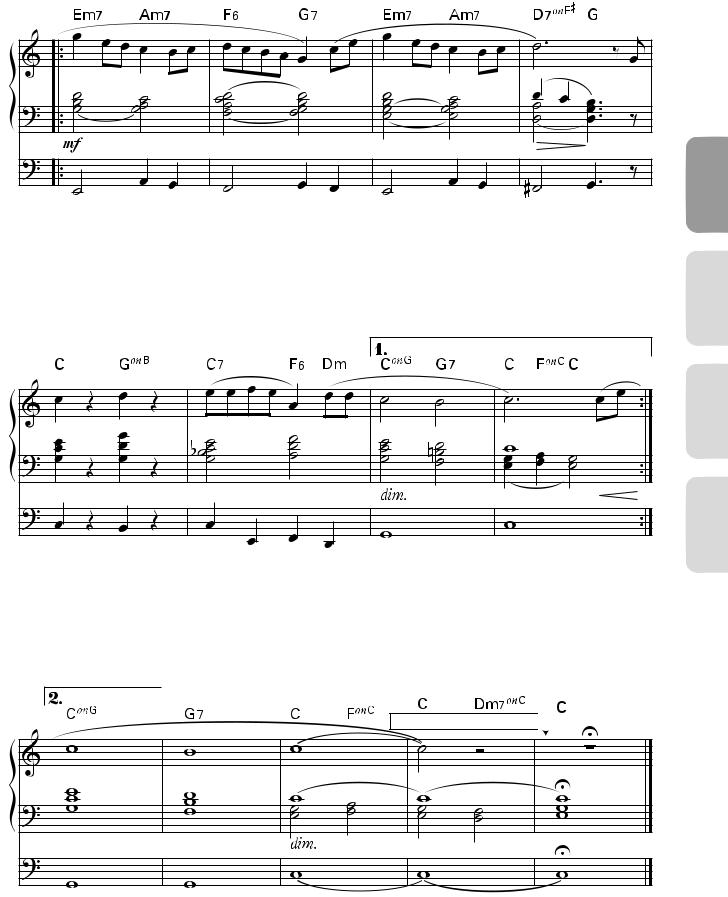
( ) |
( ) |
( ) |
( ) |
( ) |
( |
) |
ACT 1
ACT 2
( |
) |
ACT 3 |
|
||
|
|
( ) |
|
|
ACT 4 |
RHYTHM STOP (with right hand) 

Playing the ELS-01/01C — Tutorial |
9 |
|
|
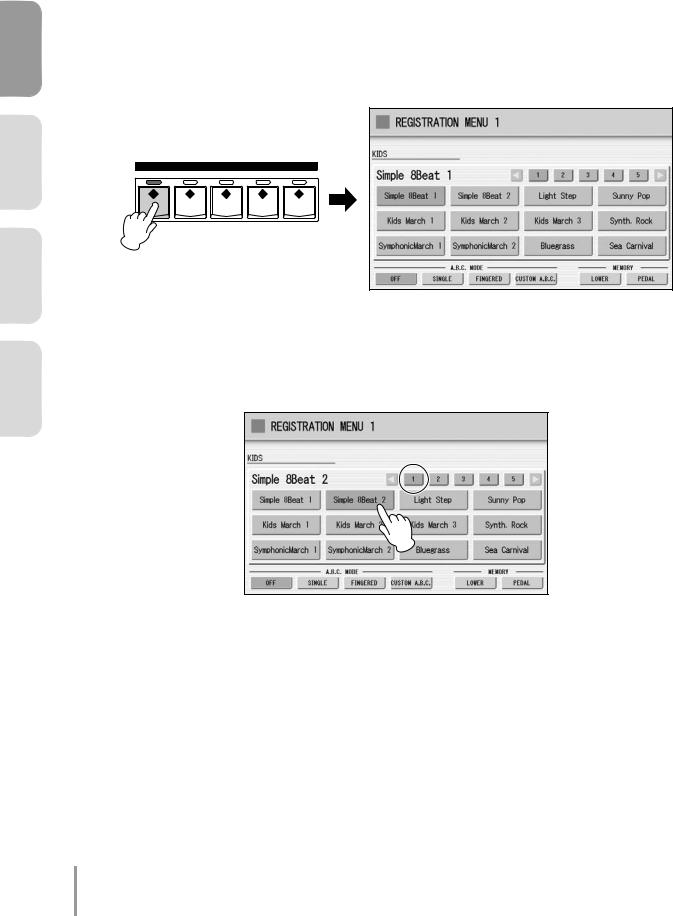
1 ACT
2 ACT
3 ACT
4 ACT
Selecting the Registration for “Grandfather’s Clock” from the Registration Menu
The simple, warm sounds of the oboe and soft strings perfectly match this melodic song, with the rhythm gently echoing the tick-tock sound of the clock.
1 |
Press the REGISTRATION MENU [1] button. |
The Kids Menu appears. |
REGISTRATION MENU
1 |
2 |
3 |
4 |
5 |
2 Select [Simple 8Beat 2] in the Kids Menu.
10 Playing the ELS-01/01C — Tutorial

Playing “Grandfather’s Clock”
1 |
Press the [SYNCHRO START] button. |
The lamp above the BAR/BEAT display flashes, indicating the rhythm is set to standby. |
SYNCHRO |
START |
START |
BAR / BEAT |
TEMPO
2 |
Play the song. |
As soon as you play the first note, the rhythm starts. Try putting some expression into your playing by using |
|
|
after touch (see page 39 of the Owner’s Manual). |
3 |
When you come to the last measure, press the [SYNCHRO START] button with your |
right hand to stop the rhythm. |
 NOTE If you want to play the song at a slower tempo, turn the TEMPO dial counter-clockwise and decrease the tempo to around 70 or so.
NOTE If you want to play the song at a slower tempo, turn the TEMPO dial counter-clockwise and decrease the tempo to around 70 or so.
TEMPO
Decreasing the tempo
BAR / BEAT
TEMPO
ACT 1
ACT 2
ACT 3
ACT 4
 NOTE Notice the tied notes in the left hand. When changing chords, be careful not to break up the continuous sound between the chords. The notes in parentheses are optional and can be left out, especially if you have difficulty playing them.
NOTE Notice the tied notes in the left hand. When changing chords, be careful not to break up the continuous sound between the chords. The notes in parentheses are optional and can be left out, especially if you have difficulty playing them.
Playing the ELS-01/01C — Tutorial 11

ACT 2
Editing a Registration
and Storing it to
Registration Memory
Song:
Dancing Queen
M 1
M 2
M 3
Creating a Simple Intro Sound based on the Registration Menu
Slightly Editing the Intro Sound
Enjoying the Original Sound
of the Registration Menu
12 Playing the ELS-01/01C — Tutorial

In this chapter, first select one of the Registration Menu buttons (as you did in ACT 1), then create three new Registrations by changing the selected Registration. You can save the created Registrations to the Registration Memory buttons first, then save them to a USB flash memory.
Here is a brief rundown of the three Registrations you’ll be using in “Dancing Queen.” Registration M1 features a clear piano intertwined with warm strings and a distinctive wah guitar in the Lower keyboard. In M2, the Synth Lead performs the melody. The last Registration, M3, is the gorgeous sound of the original Registration Menu itself.
About “Dancing Queen”
The Disco craze of the mid 1970’s swept the entire world, resulting in a huge amount of hit songs and many popular artists, such as Earth, Wind & Fire, KC & the Sunshine Band, and the Bee Gees. One of the most successful Disco-flavored acts was ABBA, the Swedish male/female team of songwriters/ singers — and “Dancing Queen” was one of their most popular songs. As you’ll discover, the Electone has a wide variety of highly danceable rhythms that are ideal for recreating the Disco sound.
ACT 1
ACT 2
ACT 3
ACT 4
Playing the ELS-01/01C — Tutorial 13

1 ACT
2 ACT
3 ACT
4 ACT
M1 Creating a Simple Intro Sound based on the Registration Menu
The original Registration Menu we’ll use for “Dancing Queen” is full and rich — perfect for this song’s main melody. However, it’s a bit too extravagant to use in the intro. So, we’ll make it a little more simple and sparse, by canceling the Melody On Chord feature and muting the Lead Voice.
1 Press the REGISTRATION MENU [3] button.
REGISTRATION MENU
1 |
2 |
3 |
4 |
5 |
2 |
Press the [2] button in the display to change the displayed menu page, then select |
||
[Disco Queen]. |
|||
|
|
|
|
3 |
Press the [A.B.C./M.O.C.] button to call up the Auto Bass Chord/Melody On Chord |
||
display, then set Melody On Chord (M.O.C. MODE) to OFF. |
|||
|
DISPLAY SELECT |
||
|
VOICE |
A.B.C. |
MDR |
|
DISPLAY |
M.O.C. |
|
|
FOOT |
UTILITY |
INTERNET |
|
SWITCH |
||
RHYTHM
PROGRAM
VOICE EDIT PATTERN SEQUENCE
U.ORGAN L.ORGAN ROTARY SP
FLUTES FLUTES SPEED
16 Playing the ELS-01/01C — Tutorial

4 |
Press the [VOICE DISPLAY] button, to call up the Voice Display, then mute both Lead |
||
Voice 1 and Lead Voice 2. (Press the buttons so they are grayed-out or “ghosted.”) |
|||
|
DISPLAY SELECT |
||
|
VOICE |
A.B.C. |
MDR |
|
DISPLAY |
M.O.C. |
|
|
FOOT |
UTILITY |
INTERNET |
|
SWITCH |
||
RHYTHM
PROGRAM
VOICE EDIT PATTERN SEQUENCE
U.ORGAN L.ORGAN ROTARY SP
FLUTES FLUTES SPEED
This completes the settings for Registration Memory 1, so record these settings to the [1] button in the Registration Memory section.
While holding down the [M.] (Memory) button in the Registration Memory section, press the [1] button.
1. While holding down [M.] button… |
2. Press the numbered button. |
|
|
|
|
|
|
|
|
|
||||||||||
|
|
|
|
|
|
|
|
|
|
|
|
|
|
|
|
|
|
|
|
|
|
|
|
|
|
|
|
|
|
|
|
|
|
|
|
|
|
|
|
|
|
|
|
|
13 |
14 |
15 |
16 |
1 |
2 |
3 |
4 |
5 |
6 |
7 |
8 |
9 |
10 |
11 |
12 |
D. |
|
|
|
|
|
|
|
|
|
|
|
|
|
|
|
|
|
|
|
|
|
|
|
|
|
|
|
|
|
|
|
|
|
|
|
|
|
|
|
|
|
|
|
|
|
|
|
|
|
|
|
|
|
|
|
|
|
|
|
|
|
|
13 |
|
14 |
|
15 |
|
16 |
|
1 |
|
2 |
|
3 |
|
4 |
|
5 |
|
6 |
|
7 |
|
8 |
|
9 |
|
10 |
|
11 |
|
12 |
|
D. |
|
|
|
|
|
|
|
|
|
|
|
|
|
|
|
|
|
|
|
|
|
|
|
|
|
|
|
|
|
|
|
|
|
|
|
|
|
|
When the Registration is being stored, the [1] button flashes momentarily.
ACT 1
ACT 2
ACT 3
ACT 4
Playing the ELS-01/01C — Tutorial 17
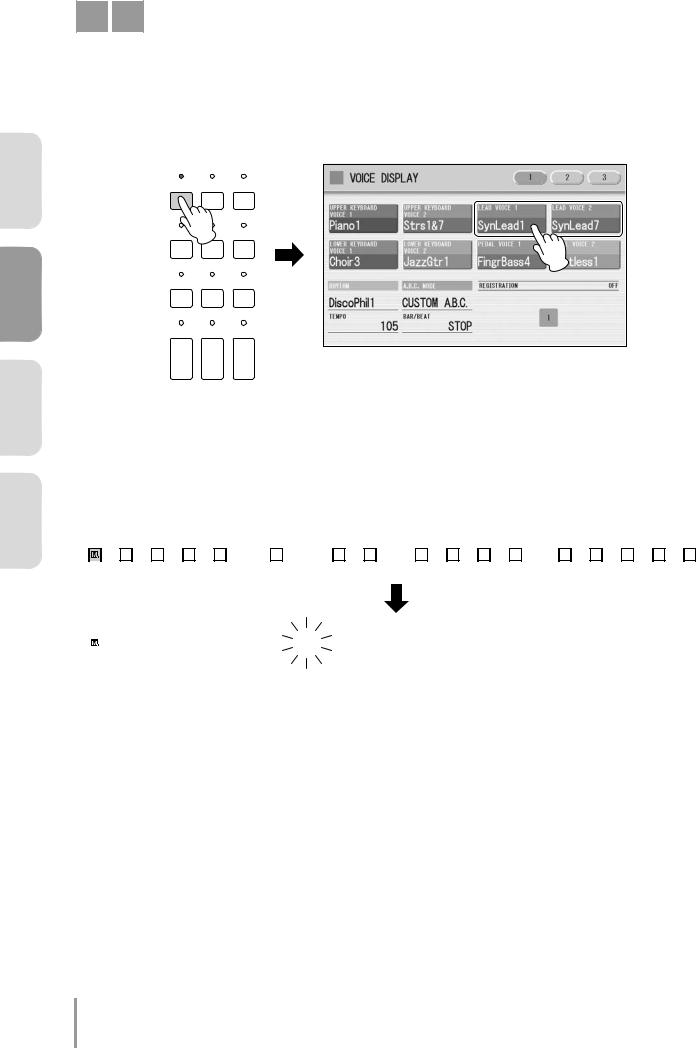
1 ACT
2 ACT
3 ACT
4 ACT
M 
 2 Slightly Editing the Intro Sound
2 Slightly Editing the Intro Sound
Here, we’ll slightly change the Registration used in the intro (M1), by turning on the Lead Voice — to better bring out the melody played on the Upper keyboard.
Press the (muted) Lead Voice 1 and Lead Voice 2 buttons in the Voice Display to turn them back on.
DISPLAY SELECT
VOICE A.B.C.
DISPLAY M.O.C. MDR
FOOT
SWITCH UTILITY INTERNET
RHYTHM
PROGRAM
VOICE EDIT PATTERN SEQUENCE
U.ORGAN L.ORGAN ROTARY SP
FLUTES FLUTES SPEED
This completes the settings for Registration Memory 2, so record these settings to the [2] button in the Registration Memory section.
While holding down the [M.] (Memory) button in the Registration Memory section, press the [2] button.
1. While holding down [M.] button… |
|
2. Press the numbered button. |
|
|
|
|
|
|
|
|
||||||||||||
|
|
|
|
|
|
|
|
|
|
|
|
|
|
|
|
|
|
|
|
|
||
|
|
|
|
|
|
|
|
|
|
|
|
|
|
|
|
|
|
|
|
|
|
|
|
|
|
|
|
|
|
|
|
|
|
|
|
|
|
|
|
|
|
|
|
|
|
|
|
|
|
13 |
14 |
15 |
16 |
1 |
|
2 |
3 |
4 |
5 |
6 |
7 |
8 |
9 |
10 |
11 |
12 |
D. |
|
|
|
|
|
|
|
|
|
|
|
|
|
|
|
|
|
|
|
|
|
|
|
|
|
|
|
|
|
|
|
|
|
|
|
|
|
|
|
|
|
|
|
|
|
|
|
|
|
|
|
|
|
|
|
|
|
|
|
|
|
|
|
|
13 |
|
14 |
|
15 |
|
16 |
|
1 |
|
2 |
|
3 |
|
4 |
|
5 |
|
6 |
|
7 |
|
8 |
|
9 |
|
10 |
|
11 |
|
12 |
|
D. |
|
|
|
|
|
|
|
|
|
|
|
|
|
|
|
|
|
|
|
|
|
|
|
|
|
|
|
|
|
|
|
|
|
|
|
|
|
|
When the Registration is being stored, the [2] button flashes momentarily.
18 Playing the ELS-01/01C — Tutorial
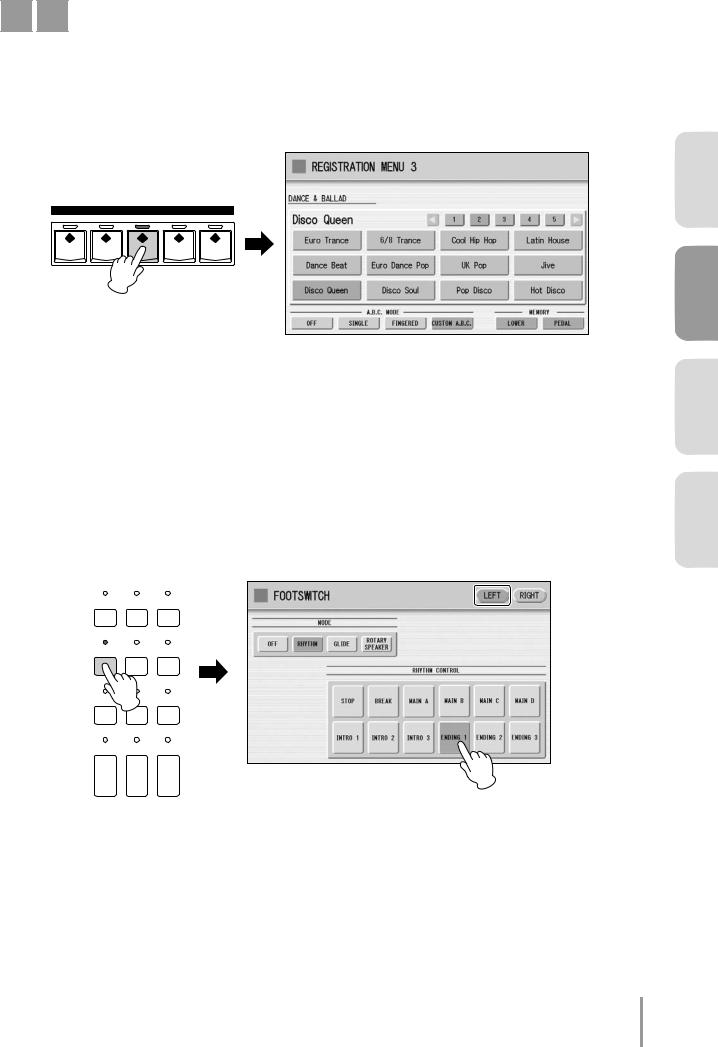
M3 Enjoying the Original Sound of the Registration Menu
For the main melody, we’ll use original Registration Menu, with no editing. Melody On Chord is set to on for the Registration Menu by default, automatically adding harmony notes to your performance.
Press the REGISTRATION MENU [3] button, then select the “Disco Queen” Registration.
REGISTRATION MENU
1 |
2 |
3 |
4 |
5 |
Footswitch Settings
● ● ● ● ● ● ● ● ● ● ● ● ● ● ● ● ● ● ● ● ● ● ● ● ● ● ● ● ● ● ● ● ● ● ● ● ● ● ● ● ● ● ● ● ● ● ● ● ● ●
You can use the footswitches on the Electone to control different performance functions — without ever having to take your hands from the keyboards! First, we’ll set the Left Footswitch function so that you can play the Ending 1 pattern with the left footswitch.
Press the [FOOT SWITCH] button to call up the Footswitch display, then press the [LEFT] button at the top right of the display.
Set the Mode to [RHYTHM], then select [ENDING 1] in the RHYTHM CONTROL section in the display.
DISPLAY SELECT
VOICE A.B.C.
DISPLAY M.O.C. MDR
FOOT
SWITCH UTILITY INTERNET
RHYTHM
PROGRAM
VOICE EDIT PATTERN SEQUENCE
U.ORGAN L.ORGAN ROTARY SP
FLUTES FLUTES SPEED
ACT 1
ACT 2
ACT 3
ACT 4
Playing the ELS-01/01C — Tutorial 19
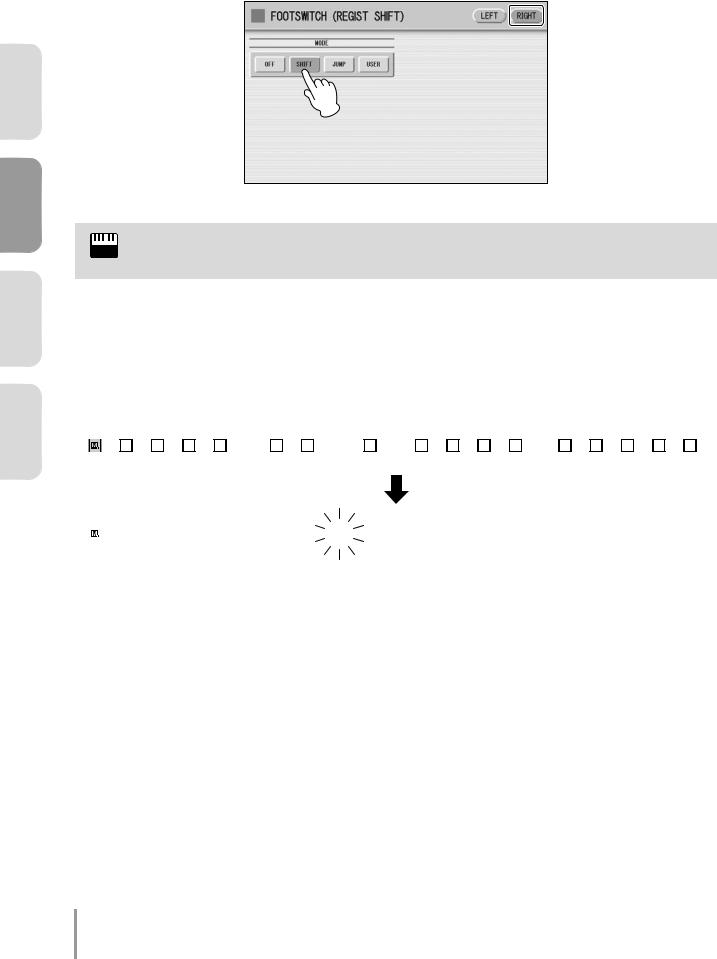
Next, set the Right Footswitch function so that you can change the Registration with the right footswitch.
Press the [RIGHT] button at the top right of the display.
Select the [SHIFT] mode as shown below.
1 ACT
2 ACT
3 ACT
4 ACT
 NOTE This setting, Registration Shift, cannot be saved to the Registration Memory buttons.
NOTE This setting, Registration Shift, cannot be saved to the Registration Memory buttons.
This completes the settings for Registration Memory 3, so record these settings to the [3] button in the Registration Memory section.
While holding down the [M.] (Memory) button in the Registration Memory section, press the [3] button.
1. While holding down [M.] button… |
|
|
2. Press the numbered button. |
|
|
|
|
|
|
|
||||||||||||
|
|
|
|
|
|
|
|
|
|
|
|
|
|
|
|
|
|
|
|
|
|
|
|
|
|
|
|
|
|
|
|
|
|
|
|
|
|
|
|
|
|
|
|
|
|
|
|
|
|
13 |
14 |
15 |
16 |
1 |
2 |
|
3 |
4 |
5 |
6 |
7 |
8 |
9 |
10 |
11 |
12 |
D. |
|
|
|
|
|
|
|
|
|
|
|
|
|
|
|
|
|
|
|
|
|
|
|
|
|
|
|
|
|
|
|
|
|
|
|
|
|
|
|
|
|
|
|
|
|
|
|
|
|
|
|
|
|
|
|
|
|
|
|
|
|
|
|
|
13 |
|
14 |
|
15 |
|
16 |
|
1 |
|
2 |
|
3 |
|
4 |
|
5 |
|
6 |
|
7 |
|
8 |
|
9 |
|
10 |
|
11 |
|
12 |
|
D. |
|
|
|
|
|
|
|
|
|
|
|
|
|
|
|
|
|
|
|
|
|
|
|
|
|
|
|
|
|
|
|
|
|
|
|
|
|
|
When the Registration is being stored, the [3] button flashes momentarily.
20 Playing the ELS-01/01C — Tutorial
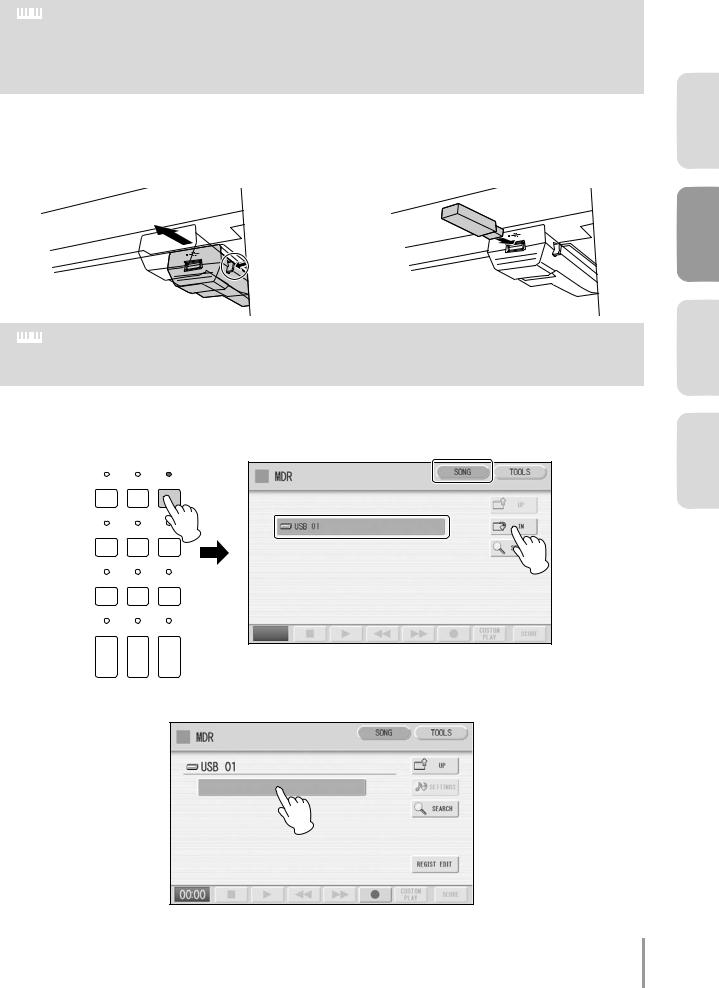
Using the Music Data Recorder
In these instructions, you’ll learn how to save your new Registration Memory settings to a USB flash memory.
 NOTE Before purchasing any USB storage device, you should check with your Yamaha dealer or an authorized Yamaha distributor for advice on compatibility.
NOTE Before purchasing any USB storage device, you should check with your Yamaha dealer or an authorized Yamaha distributor for advice on compatibility.
Before using an external media such as USB flash memory, carefully read “Precautions when using the USB TO DEVICE terminal” section on page 100.
Saving Registration Data to USB flash memory
● ● ● ● ● ● ● ● ● ● ● ● ● ● ● ● ● ● ● ● ● ● ● ● ● ● ● ● ● ● ● ● ● ● ● ● ● ● ● ● ● ● ● ● ● ● ● ● ● ●
1 Insert a USB flash memory into the USB TO DEVICE terminal.
While holding this button, pull the unit toward you.
 NOTE During your performance, make sure to slide the USB unit under the keyboard. If you leave it in the forward position, there is a danger of hitting it with your hand and breaking the USB device.
NOTE During your performance, make sure to slide the USB unit under the keyboard. If you leave it in the forward position, there is a danger of hitting it with your hand and breaking the USB device.
2 |
Press the [MDR] button in the panel to call up the M.D.R. display. |
||
In the SONG Page of the display, first press the [USB 01] button, then press the [IN] button. |
|||
|
DISPLAY SELECT |
||
|
VOICE |
A.B.C. |
MDR |
|
DISPLAY |
M.O.C. |
|
|
FOOT |
UTILITY |
INTERNET |
|
SWITCH |
||
RHYTHM
PROGRAM
VOICE EDIT PATTERN SEQUENCE
U.ORGAN L.ORGAN ROTARY SP
FLUTES FLUTES SPEED
3 Select a blank Song to which the Registration data will be saved.
ACT 1
ACT 2
ACT 3
ACT 4
Playing the ELS-01/01C — Tutorial 21

1 ACT
2 ACT
3 ACT
4 ACT
4 Press the [REGIST EDIT] button in the display.
5 |
Press the [SAVE] button in the display to save the Registration data. A message |
appears indicating the data is being saved. |
After the message disappears, press the [CLOSE] button to close the Regist Edit display.
Now, your Registration settings in Registration Memory buttons 1 – 3 have been saved to a USB flash memory.
 NOTE You can change the Song name as desired (see page 108 in the Owner’s Manual).
NOTE You can change the Song name as desired (see page 108 in the Owner’s Manual).
To call up the saved Registration data, select the song in the SONG Page of the M.D.R. display then press the [F] (Play) button.
22 Playing the ELS-01/01C — Tutorial
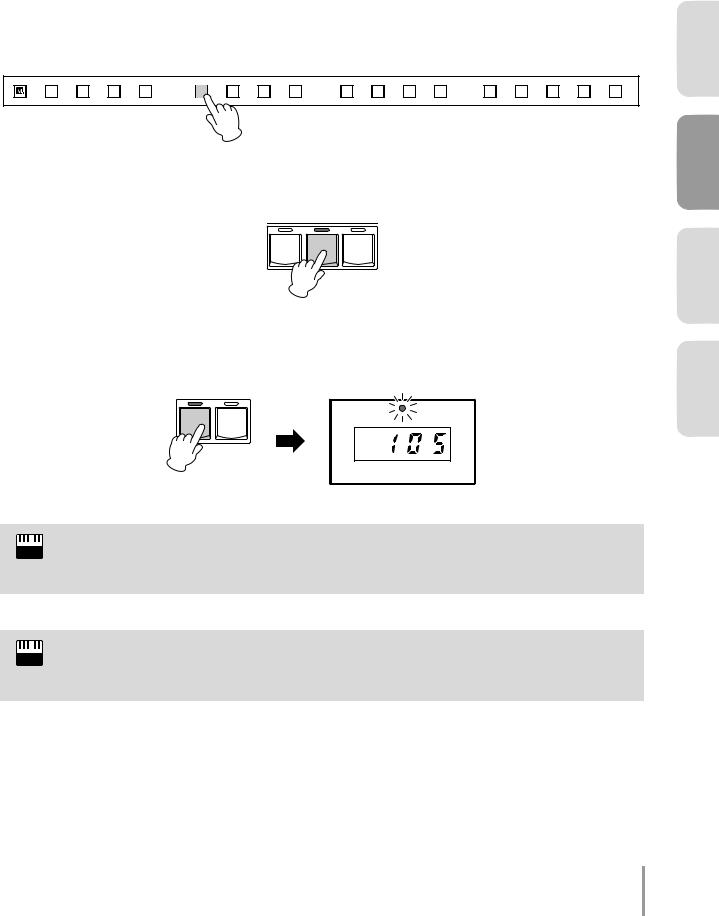
Playing “Dancing Queen”
Using your three new Registrations (M1 – M3), try playing “Dancing Queen” now.
See the notation on pages 14 – 15. At the points in the score where M2 and M3 are indicated, press the right footswitch to change the Registration Memory. At the second to the last measure, press the left footswitch to switch to the Ending pattern and stop the rhythm. Using your foot to control these features may take some practice, but mastering this technique will make your performance much more dynamic and professional.
1 Press the Registration Memory [1] button. |
|
|
|
|
|
|
|
|
|
|||||||
13 |
14 |
15 |
16 |
1 |
2 |
3 |
4 |
5 |
6 |
7 |
8 |
9 |
10 |
11 |
12 |
D. |
2 Press the INTRO [2] button on the panel.
INTRO
1 |
2 |
3 |
3 |
Press the rhythm [SYNCHRO START] button. The lamp above the BAR/BEAT display |
|
flashes, indicating the rhythm is set to standby. |
||
|
SYNCHRO |
START |
|
START |
BAR / BEAT |
|
|
TEMPO |
 NOTE In the intro section, play the right hand performance with a soft touch, as if you were adding embellishments to the auto accompaniment. (If this part is difficult for you to play, feel free to ignore it.)
NOTE In the intro section, play the right hand performance with a soft touch, as if you were adding embellishments to the auto accompaniment. (If this part is difficult for you to play, feel free to ignore it.)
 NOTE To better feel the disco rhythm with your whole body, play the pedalboard with four quarter notes every measure.
NOTE To better feel the disco rhythm with your whole body, play the pedalboard with four quarter notes every measure.
Now, start playing — in rhythm!
ACT 1
ACT 2
ACT 3
ACT 4
Playing the ELS-01/01C — Tutorial 23
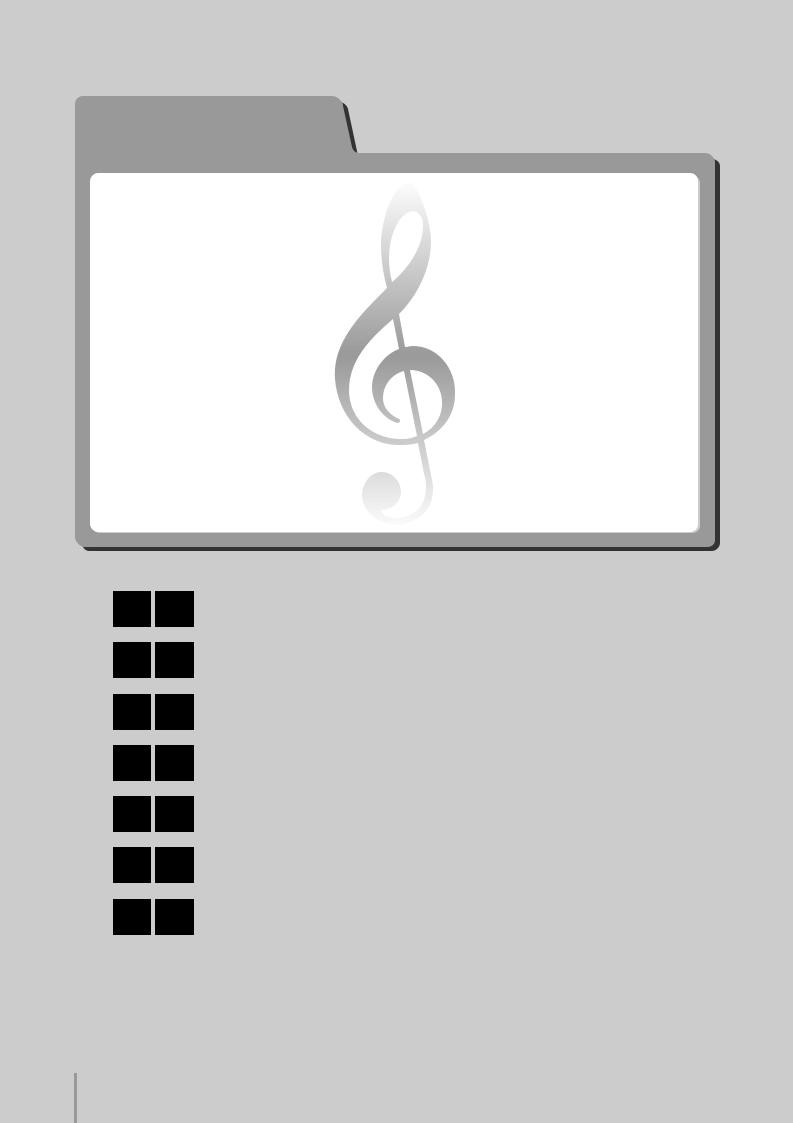
ACT 3
Selecting and Editing Voices
Working with Rhythm Sequence and Registration Sequence
Song:
Change the World
M 1
M 2
M 3
M 4
M 5
M 6
M 7
Intro with Acoustic Guitar and Electric Piano
Classic Rock Organ
Sweet Harmonica Melody
Soft Harmony with Pad Sound on the Lower Keyboard
Mysterious Arpeggio with Delay
Electric Guitar Solo
Ending with Acoustic Guitar and Electric Piano
24 Playing the ELS-01/01C — Tutorial

In Acts 1 and 2, you were able to enjoy playing the songs quickly using just the Registration Menu. However, you may want to spice up your performance with more detailed Voice settings.
In this chapter, we’ll create custom song settings from the default settings. First, we’ll select the necessary Voices and edit them with Voice controls and effects, then we’ll program a Rhythm Sequence and Registration Sequence especially for the song.
After creating the song settings, try recording your performance to a USB flash memory with the M.D.R. function. The recorded song can be played back easily.
Since going through this chapter involves many different operations, take your time, master each step in turn while you familiarize yourself with the convenient, sophisticated functions of the Electone.
Here is a brief rundown of the seven Registrations you’ll be using in “Change the World.”The acoustic guitar and electric piano accompaniment form the main part for M1, a rock organ for M2, a sweet harmonica melody and pad harmony for M3 – M4, a mysterious arpeggio for M5, and an electric guitar solo for M6. The final, ending Registration, M7, has the same settings as the intro.
About “Change the World”
This huge hit spent 13 weeks at #1 on both the Billboard and R&R charts in 1996 and captured three major Grammy awards in 1997: Song of the Year, Record of the Year and Best Male Pop Vocal Performance.
Though “Change the World” is closely identified with both Eric Clapton and Babyface, neither of those artists wrote the song. Moreover, the three acclaimed songwriters who actually composed the tune, wrote parts of it in turn and were not even in the same room together! The song was recorded first by country superstar Wynonna, and eventually found its way to Eric Clapton and Babyface, who performed and produced it for the soundtrack of the movie “Phenomenon.”
ACT 1
ACT 2
ACT 3
ACT 4
Playing the ELS-01/01C — Tutorial 25
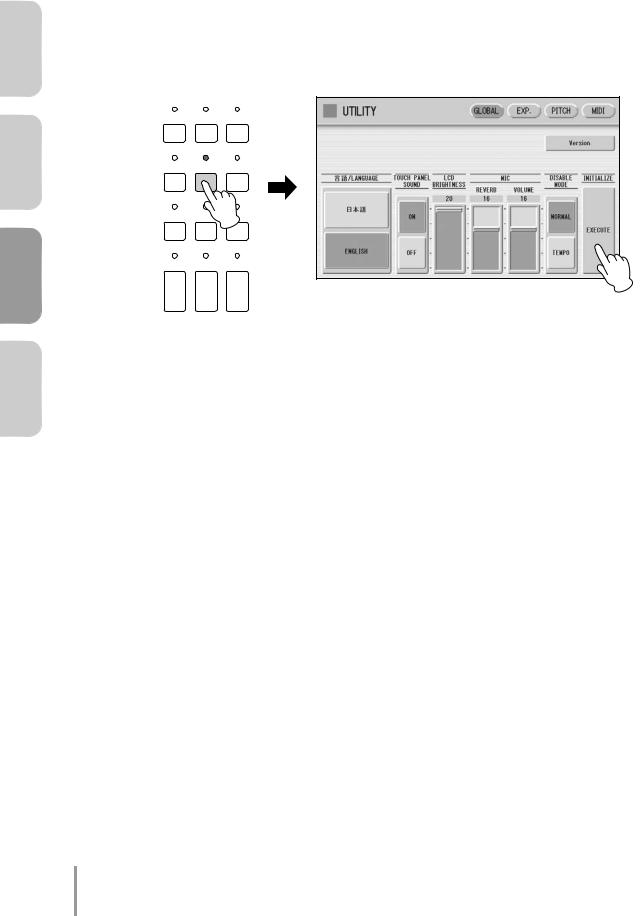
1 ACT
2 ACT
3 ACT
4 ACT
Initializing the Registration Memory
Before starting to create new song data, initialize the Registration Memory settings with the following procedure. This will erase the settings you made in the last chapter, but if you don’t reset the Registrations, you won’t get the intended results from the instructions that follow in this chapter.
1 |
Press the [UTILITY] button on the panel. |
2 Press the INITIALIZE [EXECUTE] button in the Utility display, GLOBAL Page. |
|
DISPLAY SELECT
VOICE A.B.C.
DISPLAY M.O.C. MDR
FOOT
SWITCH UTILITY INTERNET
RHYTHM
PROGRAM
VOICE EDIT PATTERN SEQUENCE
U.ORGAN L.ORGAN ROTARY SP
FLUTES FLUTES SPEED
A message prompting you to initialize the Registration data appears. Press [INITIALIZE] to go ahead and initialize the data.
The display turns dark briefly, then starts up again automatically, indicating the initialization operation is complete.
Creating the Registration Settings
How do go about creating the Registration? Where do you start? — the Voice settings for playing the melody, or the rhythm settings that determine the groove? Actually, either is fine. In these instructions, we’ll first select the Voices for each keyboard, Upper, Lower and Pedal, then make the rhythm settings.
28 Playing the ELS-01/01C — Tutorial
